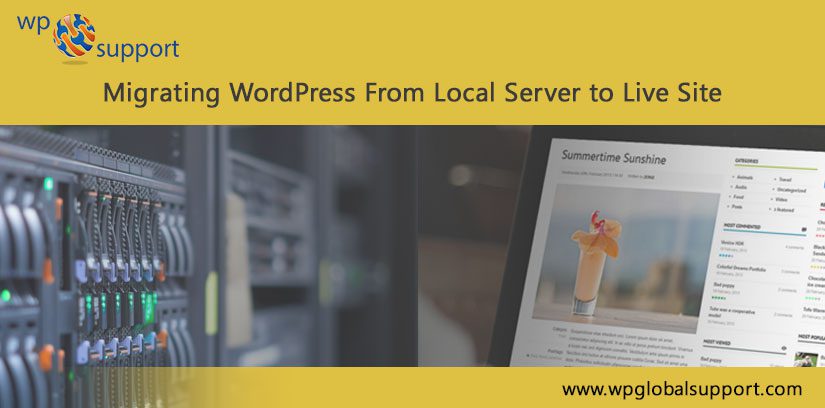
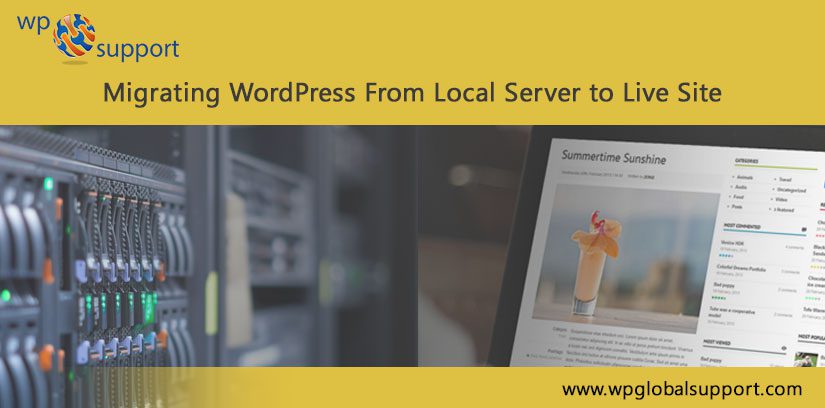
Creating a WordPress site locally is a smart method to speed up the development process. Because while you are developing a site you go through so many changes and you check those changes instantly. These rapid changes and updates harm your website and drain lots of internet data.
So, most of the WordPress experts suggest developing a website on a local server. Once you finish perfecting your website on your own PC (Personal Computer). The next tab is to move WP from the local server to the live server and share all your creations with the world.
From this blog, we like to share step-by-step instructions on how to move wordpress from Local server to Live site.
Why do we move WordPress from Local Server to Live Site?
Building your wordpress blog on a local server permits users to test changes to their site without affecting any visitors.
After the perfect finishing of your website, the next stage is to move WordPress from Local Server to Live Site.
There are two different ways to move your local server to a live site. The first way is to use a migration plugin BackupBuddy or Duplicator and the second way is to manually move wordpress from a local server to a live site.
Prerequisites
Just a few simple requirements that you will need before you start to move the local WordPress site to a live server are as follows:
In order to migrate local WordPress to the live server, you need to follow a few things. Firstly, we are pretending that you have a WordPress site running on the local server, and you have full access to your site.
Further, you will need to have a domain name and a web hosting server or provider. We have a list of the Best WordPress hosting providers. So, you can select the best for you from the list.
To speed up this process, you can use Bluehost. They are an official WordPress suggested hosting provider, and they are providing our users with an exclusive 60% discount + a free domain to you.
Lastly, you will also need to have an FTP program and must know how to use the FTP, so that you can upload your content or blog to the live site from your website, where FTP stands for File Transfer Protocol.
FTP is used to transfer files from one local computer to a remote website, such as a WordPress blog. It is also used to download files from your WordPress website to your computer or to change files and directory permissions on a remote website.
Migrate WordPress from the Local Server to the Live Site
For a successful migration of WordPress from a local server to a live site follow the 7 steps given below. Let’s get started migrating the WordPress site.
Step #1: Export Local WordPress Database

The very first thing you need to do is export your local WordPress database. And we will be using phpMyAdmin to do that.
Now simply go to http://localhost/phpmyadmin/ and press on your WordPress database. Thereafter, press the Export button from the top menu bar of your PC.

Thus in the Export Method option, you can pick the “Quick” or “Custom” method. Custom will provide you with more options to export your database in comparison to Quick. Thus we suggest picking up the Quick option and then pressing the Go button to download your database.
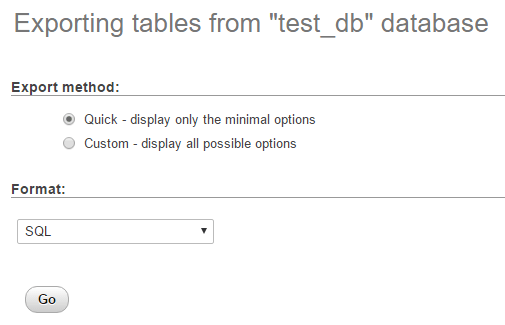
Step #2: Upload WordPress Files to Live Site
Now you will need to move all your site files to your live site.
To get started, go ahead and open your FTP client and connect to your web hosting account from your PC.
Once you are connected to your live site, make sure to upload the files to the right directory of your live site. For example, if you want the site to be hosted on WordPresssite.com, then you have to upload all the files in your public_html directory.
Thereafter select all your local WordPress files and upload the same files to your live server from the PC site on which you are working.
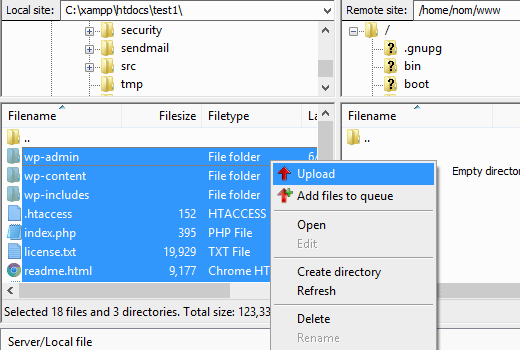
Step #3: Create a MySQL Database on Live Site
While your FTP client is uploading your WordPress files. You can start importing your database to the live server from your computer. Most WordPress hosting providers offer cPanel to manage your hosting account, so we will show you how to develop a database using cPanel.
cPanel is also known as a control panel which is basically a web hosting panel based on a Linux system and provided by many hosting providers. It provides a website with all the automation tools to simplify the process of hosting a website. Where hosting providers provide web hosting services.
Further to get started, you can log in to your cPanel dashboard and press the MySQL Databases icon from your PC which can be found in the databases section of your website.
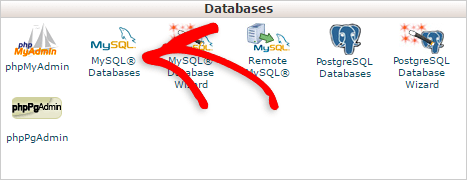
On the next window of your PC, develop a database by typing a name for your database and pressing the Create Database button from your working Window.

After developing your database, bring it down to the MySQL Users section and develop or create an existing user for the database of your website.
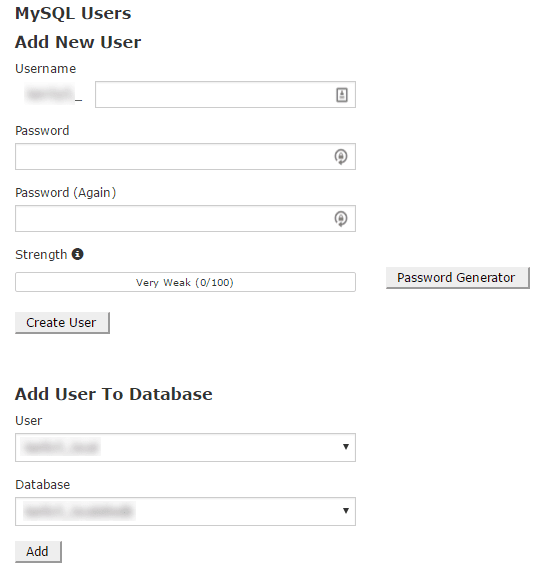
After the addition of a user, cPanel will move you to set MySQL privileges for that user that you have added. Simply grant all the privileges to the user by making sure that every box is to be checked, and then press the Make Changes button.
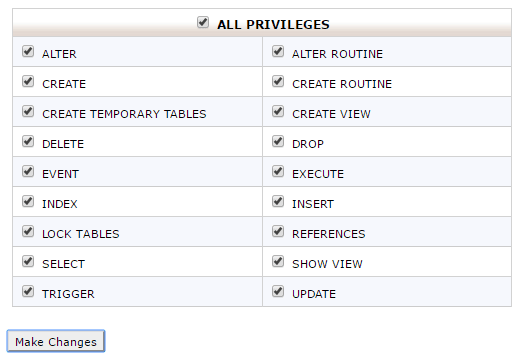
Step #4: Import WordPress Database
Now start the process of importing the database from localhost to live server WordPress. Thus, Go to your cPanel dashboard bring it down to the databases section, and press on phpMyAdmin in your working window (desktop).
This step will take you to phpMyAdmin where you wish to press on the database which you have created in Step 3. However, phpmyadmin will represent your new database with no tables to your current working window.
Press on the Import tab at the top of the menu on the import page. Press onto Choose File button and then choose the database file you have saved in Step 1.
Finally, click the Go button placed at the bottom of the window pane. PhpMyadmin will now import all your WordPress databases to your PC.
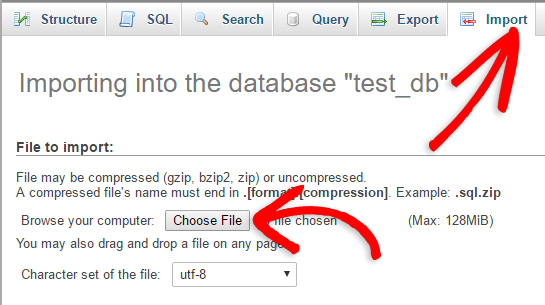
Step #5: Change the Site URL
Now, you have to change the site URL in your database from your website so that it might join with your live WordPress site which you have just developed.
In phpMyAdmin, search for the wp_options table in your database from your PC. That we just imported in step 4. If you changed your database prefix means changed your database starting, then search wp_options instead of it which might be {prefix}_options.
Press the Browse button for the next wp_options or the link that you see in the sidebar to open or reach the page with a list of fields within the wp_options table of your current working window. See a screenshot illustrated below:
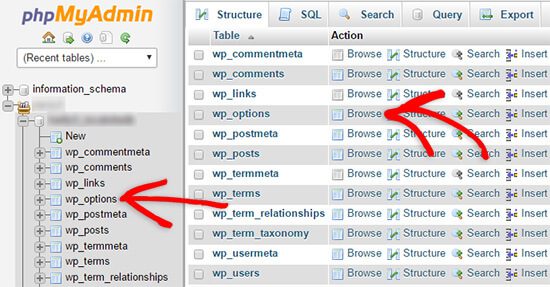
Below the field options_name, you need to see the site URL. Now press onto the Edit Field icon which can be found at the far left at the starting of the row of your window page.

When you press the edit field, an edit field window will appear in front of you. Thus in the input box for option_value, you will look at the URL of your local install. Probably something like http://localhost/test. Keep the mind to insert your new site URL in this field, for example, https://www.wpglobalsupport.com.
Save the field by pressing the Go button.
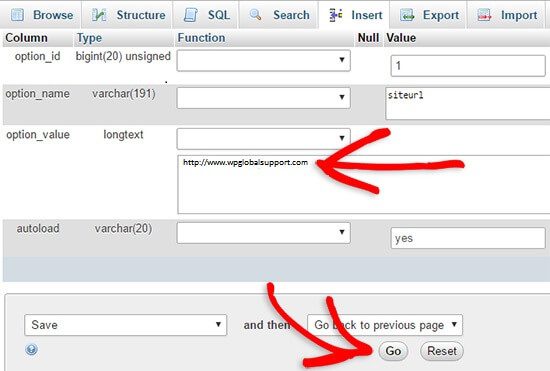
Thus, you need to reptile from this step for the option name: home. The wp_options page can be a few pages long, so as fast as you can find the home tab. Basically, it is on the second page which you can navigate to by pressing on the pagination arrows in phpMyAdmin from your PC.
Step #6: Set Up Your Live Site
Here we have imported the database, and all of our content should be uploaded. It is the time to configure WordPress. This time, your site should be representing an Error Establishing Database Connection error. To fix this error, establish a connection to your website by using an FTP client and edit the wp-config.php file to your website. Now provide the database name, user, and password you have developed earlier in Step 3. Thus, Save the wp-config.php file and upload it back to your server which you have or onto which you are working. Have a look at your website, and it should be live now.
Further, you need to log in to your WordPress admin panel of WordPress and go to WordPress settings, General. Thereafter without changing anything, bring it to the bottom and press the Save Changes button. This will make sure that the site URL is corrected anywhere else that it needs to be on your website.
Thus, after that go to Settings » Permalink and press Save Changes to confirm that all the post links are working accurately.
Step #7: Fix Images and Broken Links by Updating Paths
Thus when you are migrating a WordPress site from one domain to another. Or from the local server to a live site. You will face broken links and missing image problems definitely. Thus to overcome this problem, you can either use the SQL query or the Velvet Blues WordPress plugin.
For those who wish to do it along with SQL (structured query language). Here we have a simple SQL query that should solve this problem:
Press UPDATE wp_posts SET post_content = REPLACE(post_content, ‘localhost/test/’, ‘yourlivesite’). And you are all set.
Evaluating it: Simply go to the phpMyAdmin. Press on your database and then press on SQL from the top of the menu of your PC. Type this query, but do not forget to change it. With your own local site and live site URLs. Which you have developed write away the movement.
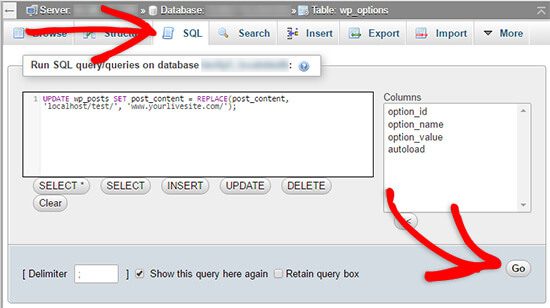
Finally, all ends! Hopefully, You have successfully moved the local WordPress site to the live server will run smoothly without any problem. Be sure to check out your website site for expected work.
Steps to transfer local server to live site using a migration plugin
This method is specially recommended for beginners. In this method, we will use a migration plugin to transfer wordpress from the local server to the live server.
Step #1: Install duplicator plugin and set up
You need to install and activate the plugin on your local site. After installing and activating the plugin, go to the wordpress dashboard and click on duplicator, click on the packages, and then create a new button.
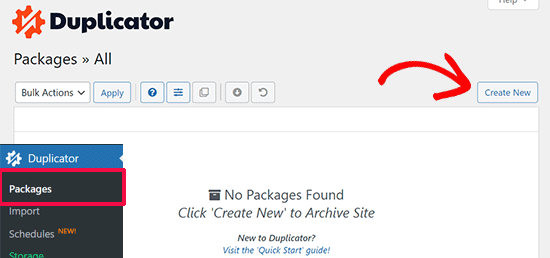
And now click on the next button
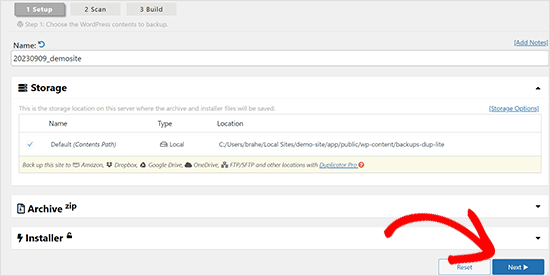
Now the duplicator will run and scan everything and if it’s all marked as good, then click on the Build button.
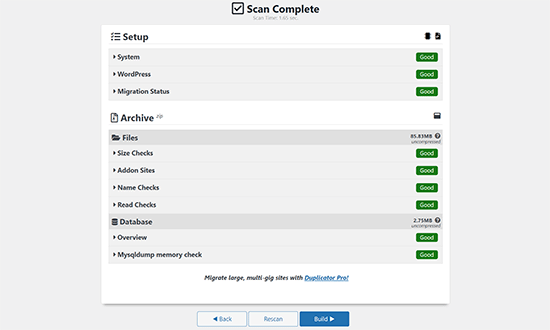
The time taken by this process depends on the size of your website. So until the process is completed, you need to leave this tab open.
After finishing this process you’ll see download options for installer and archive packages. Now click on the click download link to download both installer and archive files.
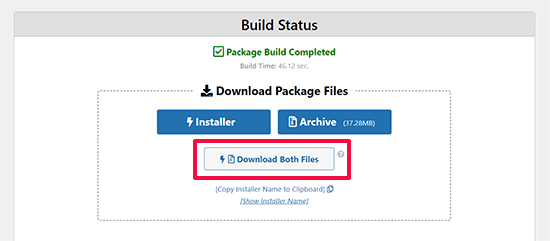
The Archive file includes all core files of wordpress as well as your uploads, images, themes, plugins, and a backup of your WP database and the installer file is a script. It will automate the complete migration process by unpacking the archive file containing your website.
Step#2: Create a database
You need to create a database for your live site before you run the installer file or archive files. Go to your hosting account’s cpanel dashboard to create your database and then click on ‘MySQL Database Wizard’ in the database section.
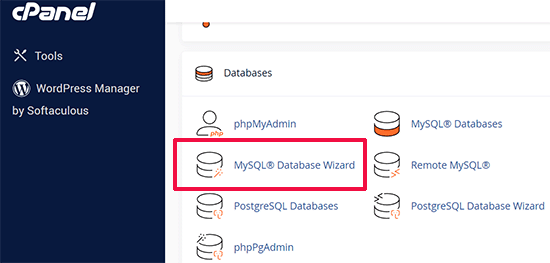
On the next screen, you will see a create database’ field, type a name for your database and click on Create New database.

Now your database is created.
After that, enter a username and password for your new user, and then click the ‘Create User’ button.
Next, create your username and password in the MySQL Users section.
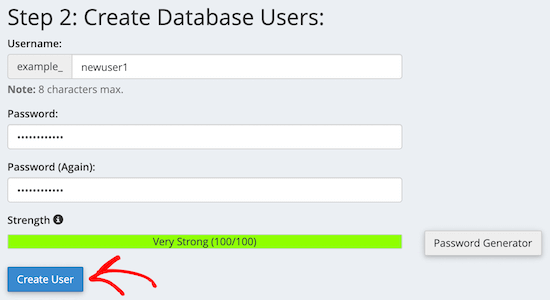
Now you need to add the user created to the database.
Click the “All privileges’ checkbox and to save your modification, scroll down and click the “Save Changes” button.
So, now your database is completed and ready to use for your WP site. It is important to keep a record of your username and password and database name.
Step#3: Upload files from the local server to the live WP site
In this step, you need to upload the archive file and installer file from your local site to your hosting account.
Firstly, using an FTP client, connect your live site. After connecting, make sure that your website’s root directory is empty. Normally /home/public_html/ folder is the root directory, but it can be any directory that you have assigned to your website.
When you sign up, some WP hosting companies automatically install wordpress. You need to remove them, if you have any WP files there and then upload the migration files.
Step#4: Running the migration script
Now, visit https://yourdomain name/installer.php, and as a result, the duplicator migration wizard will be launched. After the installer ran some tests, and initialized the scripts.
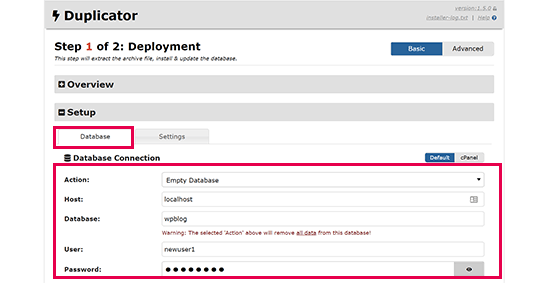
You will be asked to enter a username, password, database name, and MySQL host under the setup section.
The local host will be your host. Next, you will enter the database details that you have created. Make sure that the details are correct that you entered and then click on the “validate” button.
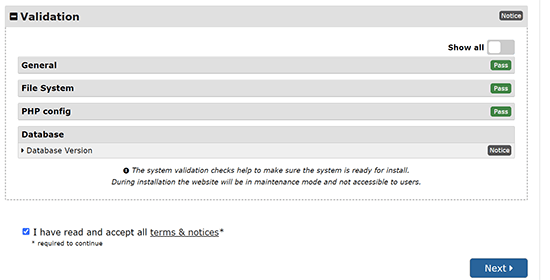
Now, to continue click on the ‘Next’ button.
Now Duplicator archive into your new database and will import your WP database backup from it.
You can now log in, and click on the ‘Admin Login’ button to enter the WP admin area of your live site.

Duplicator will clean up the installation files automatically, once you have logged in in to your live site.
Now you have successfully moved WordPress from the local server to your live site. You can also use BackupBuddy instead to move WordPress from local server to live server
Conclusion
Now you would have proper insight into what happens while moving a WordPress From Local Server to Live Site. WordPress allows for a lot of reliability and ease of use of it.
What’s your best method for uploading a WordPress Website From a Local Server to a Live Site? If you have gone through these two method before, what was your experience? Please engage your experience with us through the comments!
If you are doing this on a regular basis then we highly suggest. That you get up the BackupBuddy because it will make your life much easier than all other hosts.
In case of any help related to WordPress talk to our WordPress Technical Support Team, dial our Toll-Free number + 1 844 897 0441.
